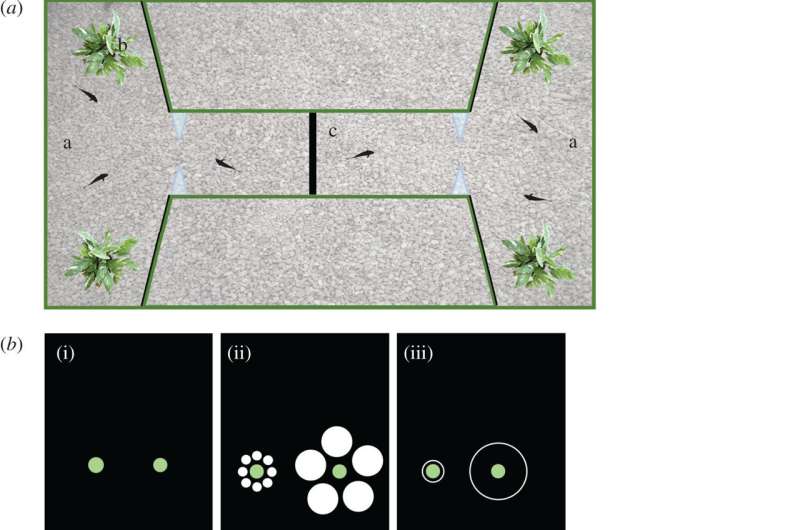(a) Experimental apparatus: a, lateral compartments; b, aquatic plants; c, panel. (b) Panel with experimental stimuli used for size discrimination trials in Experiment 1, namely the depicted panel shows 0.9 diameter ratio (i). Panels used in Experiment 2 to study Ebbinghaus (ii) and Delboeuf (iii) illusions. (c) Results of Experiment 2: boxplots represent median, first quartile, third quartile, ranges and outliers. The x-axis refers to the different types of trials (control ratios and illusory tests). The y-axis refers to the proportion of passages through the bigger hole in control panels and through the hole that is perceived as larger in teleost fishes. Asterisks (*) denote a significant departure from chance level (p < 0.05). Credit: DOI: 10.1098/rsbl.2021.0548
A team of researchers working at the University of Padova, in Italy, has found that like humans and many other animals, guppies are susceptible to optical illusions. In their paper published in the journal Biology Letters, the group describes experiments they conducted with guppies passing through holes in a fish tank.
Prior research and anecdotal evidence have shown that humans are susceptible to misinterpretation of many kinds of optical illusions—as are horses, dogs, bearded dragons, cats and nonhuman primates. And as the researchers note, while much research has been dedicated to better understanding why humans are so easily fooled by illusions, very little work has been done to understand the same in animals, particularly investigations into the effects of optical illusions that occur naturally. In this new effort, the researchers conducted experiments to determine if guppies, a type of tropical fish, are susceptible to misinterpreting the same kinds of optical illusions as humans.
In one experiment, the researchers determined that guppies, when given the choice, prefer to swim through larger holes. They placed barriers with two different-sized holes inside fish tanks and observed that the fish did indeed choose to swim through a hole that was slightly larger when given a choice. The next experiment involved placing groups of six fish in tanks with barriers containing equally sized holes that were surrounded by markings that are known to create the illusion that a hole is bigger or smaller. The fish had to swim through a hole to reach the food source. The researchers found that the fish preferred to swim through the hole that appeared larger in one illusion and preferred the hole that looked smaller in a second illusion.
The researchers suggest that guppies are just as susceptible to confusion when encountering optical illusions as other creatures, though perhaps not in the same ways. They suggest the fish chose what they thought were bigger holes in the first experiment to avoid getting stuck. In the second, they suggested the hole that appeared larger might have resembled the open mouth of a predator, which is why they chose the smaller hole, even though it might have increased their odds of becoming stuck.
More information: Maria Santacà et al, Guppies ( Poecilia reticulata ) are deceived by visual illusions during obstacle negotiation, Biology Letters (2022). DOI: 10.1098/rsbl.2021.0548
Journal information: Biology Letters
© 2022 Science X Network
























